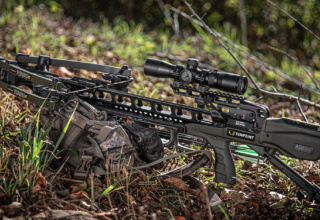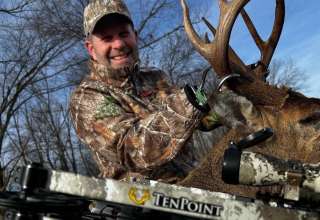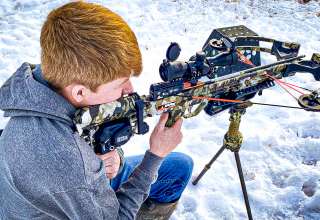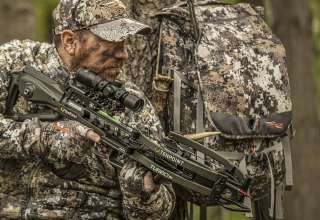Fast, nimble, safe, and dead-on accurate…TenPoint’s new Vengent S440 with an integrated de-cocking system may be the cure for your “Can’t find ammo” blues
by Rob Reaser
As centerfire rifle season for whitetails gets underway across much of the country in the next couple of weeks, we’re already hearing the cries of anguish from those who failed to prepare for the ammunition shortage the country has suffered through these last eight months. Planning to grab a box of ammo to test your rifle’s zero before heading to the woods? Probably not going to happen.
May we suggest an alternative plan of action?
In many states throughout the country, crossbows have been made legal for use during archery season and are usually allowed as a substitute for firearms during the traditional rifle season. You need to check with your state’s legislative authority on this, of course, but here is an updated roster of states detailing the status of crossbow hunting.
If you are unfamiliar with crossbows, you may think they are no substitute for a rifle. In some cases, that would certainly be true. But when you consider that most whitetails are taken within a 50-yard envelope—and when hunting in a woodland environment, it’s often much closer—a crossbow is most certainly a viable alternative. And if you are unable to get your hands on ammo for your deer rifle, a crossbow will absolutely get the job done.
One of the great things about crossbows is that they do not require the extensive learning curve that vertical/compound bows require. The platform is a familiar one, having a long-gun-style stock and a trigger. After learning the very few nuances of crossbow operation and performance, the first-timer can go from the box to the woods in short order.
Most crossbows are sold as packages, meaning they typically come with everything you need to start hunting, minus the broadheads. All that is required is to familiarize yourself with their operation, zero the scope much like you would zero a rifle scope, screw some quality broadheads into your arrows and go hunting.
Another benefit of crossbow hunting is that you can usually re-use the arrows. The speed and penetration capability of the modern crossbow typically results in pass-through shots in deer. So long as the arrow doesn’t crack or break, it can be reused again and again. The broadheads are more susceptible to damage, but often, only a fresh set of replacement blades are all that is needed to get them back in the game. So, when ammo is in short supply (or non-existent), the crossbow can effectively stand in the gap.
As you can see from a bit of online searching or a visit to a well-stocked archery retailer, there are many crossbow manufacturers in the marketplace. From experience, we will tell you that you get what you pay for. And for our money, TenPoint crossbows sit at the head of the pack. They are made in the USA at the company’s Mogadore, OH, factory and the company leads the market in crossbow innovation and quality. Yes, TenPoint crossbows carry a premium price compared to all the other crossbows made outside the US, but the cost is offset by performance, customer support, and overall value. We’ve shot many TenPoint models over the years and we have no hesitation in recommending them.
Earlier this year, TenPoint broke new ground by introducing the industry’s first safe cocking/de-cocking system in three of their top-line models. One of those is the Vengent S440, which we have been shooting since the summer months. With an MSRP of $2,049.99, the Vengent S440 is an investment, but one worth the cost of admission if you’re serious about putting meat in the freezer.
Vengent S440: Performance Basics
The best hunting crossbows pursue the same performance benchmarks. The first is speed, or arrow launch velocity. The greater the velocity, the better the downrange penetration and the flatter the arrow trajectory. The Vengent sits well beyond the average industry highwater mark of around 400 fps, capable of launching an arrow at 440 fps. That is plenty of speed for optimal terminal performance on a whitetail. For the new crossbow hunter, that kind of velocity offers another advantage.
Crossbow arrows, regardless of their velocity, will have a pronounced trajectory arc when compared to a rifle. That means there is a different aim point throughout the effective ethical shooting range of 50 yards or less (we don’t recommend shooting game with a crossbow beyond 50 yards for ethical reasons). Experienced compound bow shooters are used to gauging yardage, but the beginner crossbow hunter is not.
Crossbow scopes feature arrow drop compensation reticles, giving you aim points for designated yardages (20, 30, 40, 50 and 60 yards) based on the typical arrow weight and launch velocity. Since a fast crossbow like the Vengent features less arrow drop within a given distance than a slower crossbow—say, one shooting 200-something fps—there is more “fudge factor” when it comes to ranging a shot and ensuring a lethal hit if you happen to be off a bit on range estimation.
We also are big fans of the Vengent S440’s platform dimensions. When cocked, the axle-to-axle width is a scant 5.8 inches. That makes this crossbow exceptionally nimble to carry and easy to maneuver in tight, brushy conditions. Overall length (minus the stirrup) is 35 inches and weight is a comfortable 7.7 pounds. Balance, which is important for reducing fatigue when shouldering the crossbow and waiting for the shot, is impressive for a forward-draw crossbow.
Safety and Ease of Use
One of the perennial aggravations of using a crossbow is returning them to an un-cocked position at the end of the hunt (assuming you did not shoot an arrow). The most common method of doing this is shooting an arrow into a target. Unfortunately, that’s not always convenient or even possible. There are methods for unloading crossbows without firing them, but the problem with these is that the crossbow’s full draw weight must be controlled as the cable is let down. This can be dangerous and lead to possible bow damage.
Early this year, TenPoint introduced the revolutionary AcuSlide cocking and de-cocking system. This is a silent mechanism integrated into the stock that allows you to safely and with full control cock and de-cock the crossbow. No more shooting unloading bolts or transporting a cocked crossbow until you get home or back to camp. There is a slight learning curve required to use the AcuSlide system, but it’s really simple and practically effortless. The unique mechanism even allows you to stop at any point during the cocking and de-cocking process. The system is currently available only on the Vengent S440, Vapor RS470, and Viper S400 models.
The Package
As with all TenPoint crossbows, the Vengent S440 comes with everything you need to start hunting, minus the broadheads. This includes a variable-speed RangeMaster scope that comes “bore sighted” from the factory, six Evo-X CenterPunch carbon arrows and field tips, a 6-arrow quiver, and a soft case to carry it in.
Sight-in is easy enough. Being speed-adjustable (based on front focal plane operation) the RangeMaster scope can be set to deliver the proper arrow drop compensation for your arrow weight and bow speed. If you don’t have access to a chronograph, we recommend establishing the arrow launch velocity for your arrow weight at the archery pro shop and set the adjustment ring accordingly. After that, zero the scope at 20 yards, refine the zero at 30 yards, then check point-of-impact from 10-50 yards or 20-60 yards (whichever you choose) to make sure the aim point corresponds to the point-of-impact at all distances. With that, you’re ready to hunt.
The Tip of the Spear (so to speak)
Before hitting the woods, you’ll need to tip your arrows with broadheads. If you’re new to the crossbow game, that means choosing broadheads that are rated for crossbows. Most hunters opt for mechanical heads. With these broadheads, the blades are held inside the ferrule during arrow launch and flight, and then deploy open upon impact with the target. Crossbow-rated mechanical broadheads mean the blades are designed to remain closed when launched at modern crossbow velocities (versus mechanical heads rated for compound bows).
Another option is fixed-blade broadheads. Here, the blades are fixed in their position from launch to impact. The blades are always deployed so there’s no danger of them not opening upon impact. The only trouble with using fixed-blade broadheads has nothing to do with the broadheads themselves but on the quality of the arrow and the crossbow combination. If the arrows do not launch straight or the crossbow setup is a bit squiggly, poor arrow flight could result with fixed-blade heads due to wind planning. With a precision crossbow like the Vengent, though, we’ve not found this to be problematic.
One thing that we like about mechanicals (and some replaceable fixed-blade heads) is that you can install fresh, sharp blades. Sharp blades are EXTREMELY important for lethal hits and good penetration. Shoot a broadhead in the dirt and you need new blades before you can hunt with that head. The same is true for when you shoot an animal. If the ferrule is undamaged, simply clean it with hot, soapy water, install fresh replacement blades, and you’re good to go.
Examples of mechanical and fixed-blade broadheads that have proven themselves time and again on big whitetails include the Spitfire and the HellRazor from New Archery Products.
The Spitfire is a three-blade mechanical with forward-opening blades. It’s exceptionally accurate and delivers a 1.5-inch cutting diameter. You can buy them in 100- or 125-grain weights (we prefer the extra “umph” of the 125-grain model) and enjoy massive blood trails once you connect.
For fixed blade, there are few models on the market as rugged as the HellRazor. We say “rugged” because the HellRazor is a single-piece broadhead—from the threaded ferrule to the tip. In short, this one’s built to smash through bone and is wicked sharp out of the package. One advantage to the HellRazor is that the blades can be resharpened with the right hone and a little practice.
There are, no doubt, going to be some agitated rifle hunters over the next few weeks due to the ammo shortage. With many states allowing crossbows to be used in place of firearms and many others with extended archery seasons for which crossbows are allowed, the crossbow may be the best alternative if you find yourself staring at empty ammunition shelves. For our money, the TenPoint Vengent S440 will take you to the finish line and give you additional hunting opportunities for years to come—even after ammo returns to the stores.


























